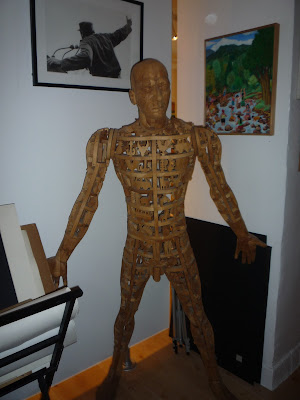By Alexander Nixon
My favorite piece in the collection of the Center for Cuban Studies is a sculpture by Cuban artist William Pérez. It is a wooden mannequin made up of tiny carved pieces that resembles a kind of human-scale 3D puzzle. When I look at it, I am reminded of how we are the sum so many random and often contradictory thoughts, desires, expectations, and impulses. It is only by a miracle of the mind that we can make coherent sense out of all the parts and keep ourselves from falling to pieces.
Such a Herculean effort is required to make sense out of the incendiary rhetoric in America about Cuba. But if you aren't up to the task, the Center for Cuban Studies is here to help.
In June 2010, the Director of the Center for Cuban Studies, Sandra Levinson, as well as videographer Jenny Hellman, sat down with Mr. Pérez to do an interview (see interview below) about his art and the vicissitudes of the art scene in Cuba.
Halfway through the interview he is asked about how he manages to work in such a small studio. He looks around his tiny work space and states that "a fish grows according to the aquarium in which it lives."
This struck me as an apropos metaphor for how the Cuban government has allowed the arts to flourish in Cuba.
Unfortunately, most Americans only hear the hackneyed, Cuban exile-driven discourse about the lack of political freedom in Cuba. But artists like William Pérez and the numerous other artists interviewed in the Cuban Art Space’s interview series offer a refreshing counter-narrative to this viewpoint.
Indeed, the Cuban aquarium has provided Cuban artists plenty of space in which to swim.
To be sure, early in the revolution Cuban government had a more ambivalent attitude towards the arts than it does now. The Beatles were famously outlawed, we recall. But that was before John Lennon wrote You Say You Want a Revolution. ;)
If we were over-cynical, we might claim that Cuban artists and the Cuban government supporting them are just capitalizing on the temporary buzz about Cuba in an ever capricious international art market.
That may be true, to some degree. But watching Mr. Pérez’ interview and the other Cuban Art Space interviews, --> click here for more Cuban artist interviews <-- we learn that the Cuban government’s support for free arts education goes back decades.
Behind the wonderful, imaginative, and sui generis art coming out of Cuba is the free education, scholarships, and institutional support of the Cuban government.
Furthermore, as Mr. Pérez explains in his interview, Cuba is rapidly expanding the dimensions of its creative aquarium, giving more space to artists for workshops, galleries, and allowing the arts to blossom in neglected and overlooked spaces that the government does not have the funds to restore.
Just as much as Cuba’s well-documented success in the fields of education and public health, the success of Cuban artists like Mr. Pérez serves as an excellent advertisement for the overlooked positive narrative of the Cuban Revolution.
The Center for Cuban Studies won a landmark lawsuit against the US Treasury Department in 1991 (Dore Ashton v. Newcomb) that granted the Center the right to import Cuban artwork. Ever since, the Center has been an epicenter of access to the contemporary world of Cuban art for curious Americans.
Please check out Mr. Pérez’ interview below as well as the others in the Cuban Art Space Interview Series. Cuban artists are not, in fact, asphyxiating in a tiny communist aquarium. On the contrary, it is we Americans who are trapped inside the thick glass of a failed foreign policy that keeps the wonderful artistic renaissance of Cuba just beyond our view.
---------------------------------------------------------------------------------------------------------------------------
William Pérez is one of Cuba's most celebrated sculptors and installation artists. Born in Cienfuegos, he moved to Havana a few years ago, thus fulfilling a dream of having his own small workspace in the capitol city. Mr. Pérez has shown in the Cuban Art Space before, in a one-man show (2000) and together with Adrian Rumbaut in an installation exhibit "Entre Nos/Between Us" (2002). In November 2003, William was invited to participate in the prestigious Havana Biennial. In October 2011 William Pérez and his Cuban collaborator, Marlys Fuego (see blog post about her), will be exhibiting new works at The Cuban Art Space.
---------------------------------------------------------------------------------------------------------------------------
Alexander Nixon is the Organizational Development Coordinator for the Center for Cuban Studies / The Cuban Art Space.


No comments:
Post a Comment